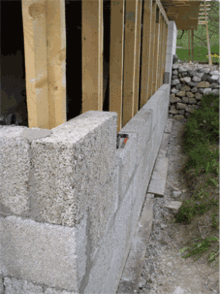Hempcrete

Hempcrete or Hemplime is bio-composite material, a mixture of hemp hurds (shives) and lime (possibly including natural hydraulic lime,[1] sand, pozzolans) used as a material for construction and insulation.[2] It is marketed under names like Hempcrete, Canobiote, Canosmose, and Isochanvre.[3] Hempcrete is easier to work with than traditional lime mixes and acts as an insulator and moisture regulator. It lacks the brittleness of concrete and consequently does not need expansion joints.[3] The result is a lightweight insulating material ideal for most climates as it combines insulation and thermal mass.
Like other plant products, hemp absorbs CO2 from the atmosphere as it grows. Furthermore the carbonation of the lime during curing adds to this effect as lime turns to limestone.[4]
Hempcrete is one of the best performing, non-toxic, ecological and renewable materials available. It has a negative CO2 footprint thus alleviating the Greenhouse effect. It improves air quality, energy consumption for heating and cooling providing a comfortable and healthy living environment. It's cool in summer and warm in winter.
The typical compressive strength is around 1 MPa,[5] around 1/20 that of residential grade concrete. It is a low density material and resistant to crack under movement thus making it highly suitable for use in earthquake prone areas. Hempcrete walls must be used together with a frame of another material that supports the vertical load in building construction, as hempcrete's density is 15% that of traditional concrete.[6]
Like other plant products, the hemp crop absorbs carbon dioxide gas as it grows, retaining the carbon and releasing the oxygen. 165 kg of carbon can be theoretically absorbed and locked up by 1 m3 of hempcrete wall during manufacture.[7]
Limecrete, Ltd. (UK) reports a fire resistance rating of 1 hour per British/EU standards.[8]
References
- ↑ Allin, Steve. Building with Hemp, Seed Press, 2005, ISBN 978-0-9551109-0-0. (p. 146, 1st Edition).
- ↑ "NNFCC Renewable Building Materials Factsheet: An Introduction". National Non-Food Crops Centre. February 21, 2008. Retrieved 2011-02-16.
- 1 2 Priesnitz, Rolf B. (March–April 2006). "Hemp For Houses". Natural Life Magazine.
- ↑ "Minoeco - Natural Plasters & Bioclimatic Design, Hempcrete".
- ↑ "Tradical Hemcrete 2008 Information Pack". American Lime Technology. Retrieved 2009-08-25.
- ↑ Flahiff, Daniel (August 24, 2009). "Hemcrete®: Carbon Negative Hemp Walls". Inhabitat.
- ↑ "Tradical Hemcrete 2008 Information Pack". American Lime Technology. Retrieved 2010-05-15.
- ↑ Abbott, Tom (2014-04-26). "Hempcrete Factsheet". The Limecrete Company, Ltd.
External links
- Hemcrete application data from Limetechnology
